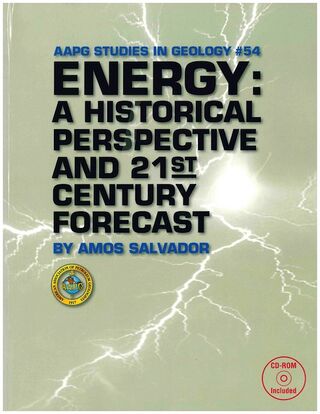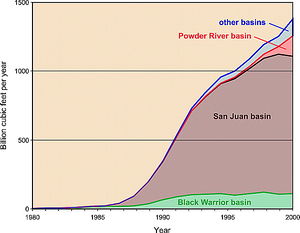Coalbed methane
| Energy: A Historical Perspective and 21st Century Forecast | |

| |
| Series | Studies in Geology |
|---|---|
| Chapter | Sources of Energy |
| Author | Dr. Amos Salvador |
| Link | Web page |
| PDF file (requires access) | |
The occurrence of natural gas in coal beds has been recognized for hundreds of years, because it is commonly released from the coal and occasionally causes deadly explosions in underground coal mines. Coal is the most abundant energy source in the Earth, and it should therefore be expected that large volumes of gas, generally called coalbed methane (CBM), should be present in coal deposits throughout the world, providing an enormous potential energy resource.[1]
Coalbed methane is generated during the coalification process, and most of it (98%) is found adsorbed in the coal, which is a microporous solid with large internal surface areas in the matrix pore structure that can adsorb very large amounts of gas. Lesser amounts can occur as free gas in fractures (called cleats) and large pores, and/or dissolved in the groundwater present in pores and fractures; coal serves as both the source and the reservoir rock for the coalbed methane.
Gas produced from coal beds is composed mainly of methane (in excess of 95%) and very minor amounts of heavier hydrocarbons (mostly ethane and propane), nitrogen, and carbon dioxide (CO2).
The gas content of coal beds generally varies with the rank of the coal and its depth of burial; the higher the coal rank and the greater the depth, and the resulting pressure to which the coal has been subjected, the greater its potential gas content. For a given coal rank, the adsorbed gas content increases with increasing pressure and decreases with increasing temperature.

Attempts to drill into coal beds to draw out their contained gas and, in this way, reduce mining hazards were first made in Europe in the late 19th century, but recognition of its potential as an energy source and the exploration for and commercial production of coalbed methane did not occur until the late 1970s and early 1980s in the United States (in the Black Warrior basin of Alabama and in the San Juan basin of New Mexico and Colorado; Figure 1). Significant exploration for and production of coalbed methane in these basins began in the U.S. in the mid-1980s, encouraged by a federal tax credit granted for the production of this abundant energy resource. It was predicted by some that interest in the production of coalbed methane would decrease or even die with the termination of the tax credit at year-end 1992, but this has not been the case, probably because natural gas is considered a desirable clean source of energy, and because the development of new production technology has made possible the profitable production of coalbed methane even without the tax-credit stimulus. From its origin as an experimental coal-mine degasification procedure, coalbed methane is becoming a promising new worldwide source of energy. In the United States, it has now grown to provide 7% of the total natural-gas production. Coalbed methane no longer deserves to be called an unconventional gas source; a mining hazard for many decades, it has become an economically viable conventional natural gas source.
See also
- Historical sources of energy
- Natural-gas liquids
- Natural gas: history and forecast
- Natural gas occurrence
- Coal bed methane (Wiki Write Off entry)
References
- ↑ Bibler, C. J., J. S. Marshall, and R. C. Pilcher, 1998, Status of worldwide coal mine methane emissions and use: International Journal of Coal Geology, v. 35, nos. 1-4, p. 283-310.
- ↑ Salvador, A., 2005, Energy-A historical perspective and 21st century forecast: AAPG Studies in Geology 54, 208 p.